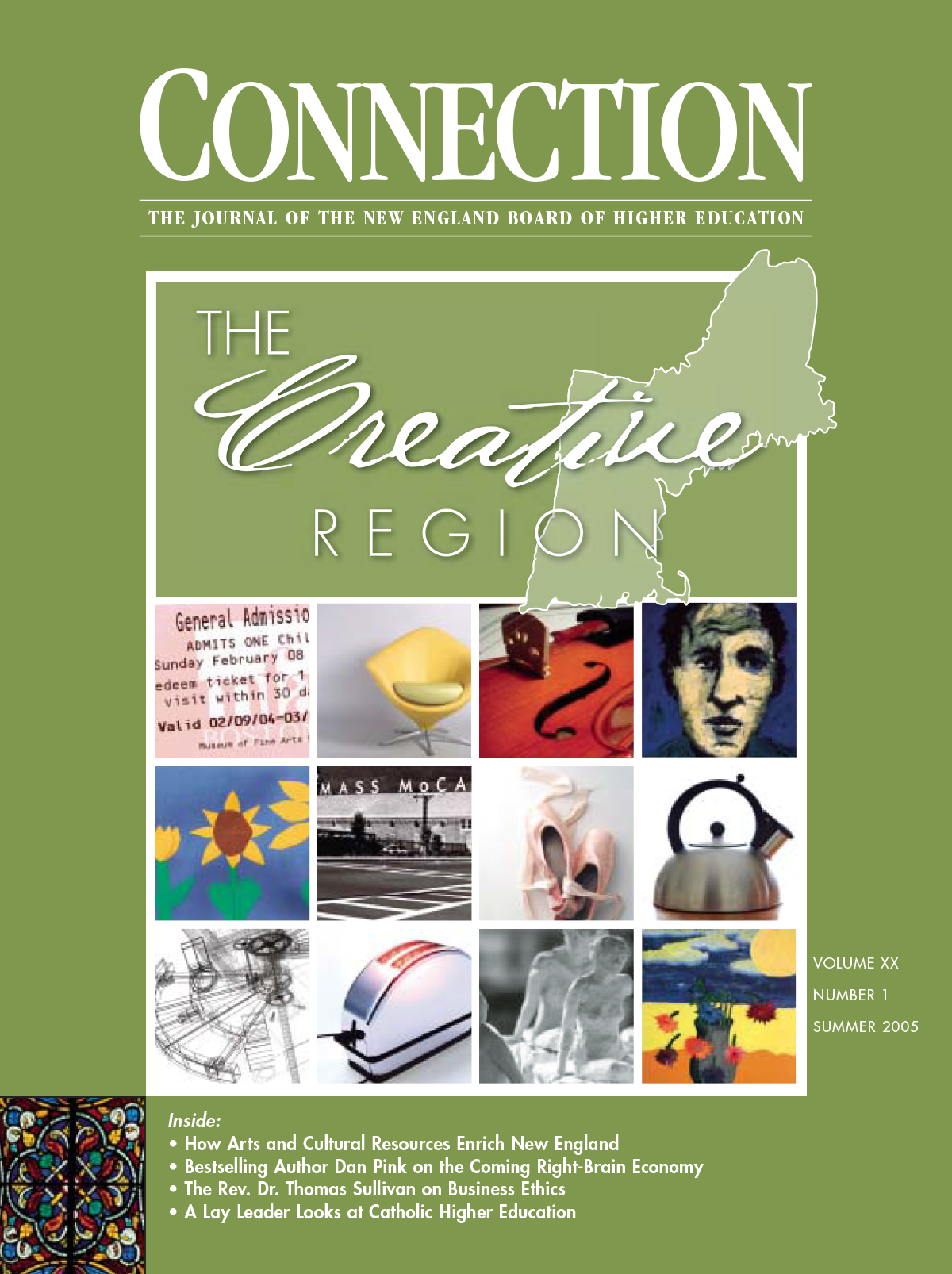
Click the cover image to view and download this issue in PDF format.
BOSTON—New England’s rich base of arts education programs, museums, symphonies and dance troupes not only enrich the region’s quality of life and generate significant revenue on their own, but also serve as midwives to a burgeoning “creative economy,” according to the Summer 2005 issue of Connection: The Journal of the New England Board of Higher Education.
The creative economy encompasses a range of professions and endeavors where competitiveness depends not on linear, analytical thinking, but rather on right-brained skills such as artistry and empathy.
This new creative economy faces stiff challenges, however. New England’s nonprofit arts endowments, museums and local theater companies are engaged in a constant battle for resources. And with each big corporate merger, a real or potential patron of the arts is gone from the landscape. In addition, schools are dropping art classes as they become increasingly focused on standardized math and language tests.
Connection is the journal of the nonprofit New England Board of Higher Education—and America’s only regional journal on higher education and the economy.
Among articles in the Summer 2005 Connection:
- Best Practices for a Creative Economy • nebhe President Evan S. Dobelle draws lessons about how New England colleges help foster the creative economy in their communities. Dobelle says it’s time to “focus our energy on becoming a global cultural capital.”
- Artists Only? • In his quarterly Editor’s Memo column, Connection Executive Editor John O. Harney warns that while New England celebrates the promise of the creative economy, it could lose its capacity to prepare the future workers needed to sustain it and the citizen-consumers able to navigate it.
- A Vocation of the Imagination • “In an educational system that prizes high retention and completion rates, what room is there for eccentricity?” asks Marlboro College President Ellen McCulloch-Lovell, who served as deputy assistant to President Clinton and advisor to the first lady. McCulloch-Lovellwrites: “Institutions should not be so consumed with measurements that they do not allow for the unstructured time necessary for discovery and experimentation—to link previously unrelated elements, recognize emerging patterns and take risks—all so essential to creativity.”
- The Coming Right-Brain Economy • Connection interviews bestselling author and former Gore speechwriter Daniel Pink about what Pink sees as the new right-brained economy. The only way companies and nations can differentiate goods and services in today’s overstocked, computerized marketplace, says Pink, is to “make their offerings transcendent—physically beautiful and emotionally compelling.” As a result, he contends, logical, linear thinking will no longer cut it in today’s workplace. The abilities that matter most will be previously undervalued skills such as artistry, empathy and seeing the big picture. As a result, adds Pink, “the MFA is the new MBA.”
- Art Transforms Education • The quantifiable measures required by many state and federal education laws are actually driving out the kind of learning and pedagogy that help develop the very right-brain thinking that futuristic thinkers are calling for. Massachusetts College of Art President Katherine Sloan and Boston Arts Academy Headmaster Linda Nathan explain how a Boston pilot school uses the critique method to buck that trend and put student learning center stage.
- Arts and the City • More than one-quarter of Boston public school ninth-graders will never finish high school. But all the Boston youth working at the nonprofit Artists For Humanity graduate from high school and continue on to higher education. Founder and artistic director Susan Rodgerson and Blenda J. Wilson, president and CEO of the Nellie Mae Foundation, explain how the initiative is tapping the creative energy of urban youths.
- Investing in Futures • For most parents, the bottom line when researching colleges for their children is how well the institution will prepare its students for the “real world,” and many art programs do the same, guiding students into “applied arts” programs. Connecticut’s Lyme Academy College of Fine Arts is one of just three institutions nationally that focuses on “fine arts only.” Lyme President Emeritus Henry E. Putsch explains how this classical approach enriches the region as it “asserts ‘the hand of the artist’ in a culture that is becoming electronic and digital.”
- Creative Places • Rhode Island School of Design (RISD) President Roger Mandle explains how a range of institutes and collaborations have helped RISD help Providence, Rhode Island, to develop a premier creative economy.
- Museum Quality • North Adams, Massachusetts, is experiencing a renaissance of sorts, marked by an influx of artists, writers, filmmakers and other “right-brained” individuals. Massachusetts College of Liberal Arts President Mary Grant explains how a new museum and a recharged state college have the creative juices flowing in this corner of Massachusetts.
- Just Power? • We teach, too often, that the marketplace is the arbiter of value, and of values, ignoring the realities of harm and injustice that markets sling about them on the way to determining price, according to the Rev. Dr. Thomas Sullivan, director of spiritual life at Babson College. Sullivan ponders the state of business ethics and business education.
- Called • James Mullen reflects on the path that has led him from the chancellorship of the University of North Carolina at Asheville to the presidency of the Catholic Elms College in Massachusetts. The Catholic tradition, Mullen promises, “offers a wide intellectual field on which to play.”
- Excerpts • More than four in 10 college-bound Connecticut high school seniors left the state in 2000 (the last year reported), adding to the state’s much talked about brain drain. But by some measures, Connecticut has also become a brain gainer. Connection excerpts “Plumbing Connecticut’s Brain Drain,” an article by Steven P. Lanza from the Spring 2005 issue of The Connecticut Economy.
- Books • Judith Greiman, president of the Connecticut Conference of Independent Colleges, reviews The Naked Roommate: And 107 Other Issues You Might Run Into in College by Harlan Cohen.
[ssba]
